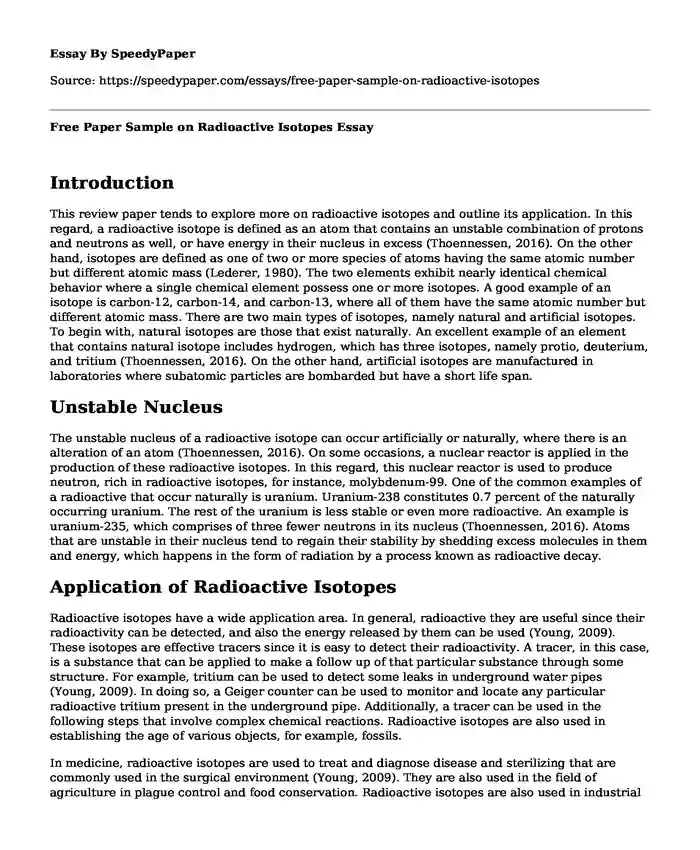Introduction
This review paper tends to explore more on radioactive isotopes and outline its application. In this regard, a radioactive isotope is defined as an atom that contains an unstable combination of protons and neutrons as well, or have energy in their nucleus in excess (Thoennessen, 2016). On the other hand, isotopes are defined as one of two or more species of atoms having the same atomic number but different atomic mass (Lederer, 1980). The two elements exhibit nearly identical chemical behavior where a single chemical element possess one or more isotopes. A good example of an isotope is carbon-12, carbon-14, and carbon-13, where all of them have the same atomic number but different atomic mass. There are two main types of isotopes, namely natural and artificial isotopes. To begin with, natural isotopes are those that exist naturally. An excellent example of an element that contains natural isotope includes hydrogen, which has three isotopes, namely protio, deuterium, and tritium (Thoennessen, 2016). On the other hand, artificial isotopes are manufactured in laboratories where subatomic particles are bombarded but have a short life span.
Unstable Nucleus
The unstable nucleus of a radioactive isotope can occur artificially or naturally, where there is an alteration of an atom (Thoennessen, 2016). On some occasions, a nuclear reactor is applied in the production of these radioactive isotopes. In this regard, this nuclear reactor is used to produce neutron, rich in radioactive isotopes, for instance, molybdenum-99. One of the common examples of a radioactive that occur naturally is uranium. Uranium-238 constitutes 0.7 percent of the naturally occurring uranium. The rest of the uranium is less stable or even more radioactive. An example is uranium-235, which comprises of three fewer neutrons in its nucleus (Thoennessen, 2016). Atoms that are unstable in their nucleus tend to regain their stability by shedding excess molecules in them and energy, which happens in the form of radiation by a process known as radioactive decay.
Application of Radioactive Isotopes
Radioactive isotopes have a wide application area. In general, radioactive they are useful since their radioactivity can be detected, and also the energy released by them can be used (Young, 2009). These isotopes are effective tracers since it is easy to detect their radioactivity. A tracer, in this case, is a substance that can be applied to make a follow up of that particular substance through some structure. For example, tritium can be used to detect some leaks in underground water pipes (Young, 2009). In doing so, a Geiger counter can be used to monitor and locate any particular radioactive tritium present in the underground pipe. Additionally, a tracer can be used in the following steps that involve complex chemical reactions. Radioactive isotopes are also used in establishing the age of various objects, for example, fossils.
In medicine, radioactive isotopes are used to treat and diagnose disease and sterilizing that are commonly used in the surgical environment (Young, 2009). They are also used in the field of agriculture in plague control and food conservation. Radioactive isotopes are also used in industrial radiography. In this application, a gamma source is used to carry out stress testing and also checking the integrity of welds (Winker, 2009). For instance, radioactive isotopes are used in the testing of airplane engines where they determine the engine's structural integrity.
Conclusion
Thus, these isotopes are also used for gauging purposes to measure or detect the level of liquid in a container (Winker, 2009). They also used in the detection of clandestine nuclear activities in weapon production. Finally, radioactive isotopes are used in scientific research to trace the flow attributed by contaminants in the biological system. Therefore, they help to determine metabolic processes in small Australian animals.
References
Lederer, C.M. (1980). Isotopes. In M. Grayson & D. Eckroth, Encyclopedia of Chemical Technology (pp.838-865). New York.
https://escholarship.org/uc/item/5p30c8f5
Thoennessen, M. (2016). Unbound isotopes. The Discovery of Isotopes, 275-291.
https://doi.org/10.1007/978-3-319-31763-2_16
Winker, M. A. (2009). Isotopes. AMA Manual of Style.
https://doi.org/10.1093/jama/9780195176339.021.231
Young, R. K. (2009). Radioactive isotopes. AMA Manual of Style.
https://doi.org/10.1093/jama/9780195176339.021.218
Cite this page
Free Paper Sample on Radioactive Isotopes. (2023, Nov 08). Retrieved from https://speedypaper.com/essays/free-paper-sample-on-radioactive-isotopes
Request Removal
If you are the original author of this essay and no longer wish to have it published on the SpeedyPaper website, please click below to request its removal:
- Free Essay: Towards a Caribbean Community
- Lab Report Essay Example
- Free Essay Describing Chinese Nationalism
- Essay Sample on Evolution of Disaster Recovery Plans
- Compare or Contrast 2 Artworks. Free Essay
- Free Essay - Geriatric Windshield Survey Table
- Essay Sample on Protocol for Determining if the Cause of the Incident is Criminal
Popular categories





